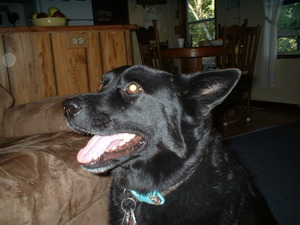Understanding a dog’s body language can be very important. We all know that when a dog is baring its teeth, snarling or growling and has the fur raised on its back, it is not a happy camper and isn’t in the mood for cuddling. There are certain other stances and body languages that a dog uses to show emotions.
In order to better read what your dog or a strange dog is thinking, you will need to look at several key issues. One is body stance. If a dog is standing very rigid and stiff with its tail held erect it is probably feeling dominant or aggressive. The dog that is feeling dominant will usually stare at the person or other dog it is trying to intimidate. Dogs that are showing signs of dominance will also growl and may bite. If you happen across a dog that is showing signs of being overly dominant do not look the dog in the eyes, and try to back away slowly without speaking.If your own dog is showing signs of being dominant is would be a good idea to get it to a professional dog handler and trainer as soon as possible.
Another way a dog shows dominance is to act aggressive. Aggressiveness is even worse then dominance because the dog may attack without much warning. Aggressive dogs can be very dangerous, especially to small children. The body language an aggressive dog uses is normally that it will have a very stiff stance with its ears held back.It too, will stare at its opponent There will be bared teeth and growls, although some aggressive dogs will simply attack without doing any of those things. If you come across a dog that is behaving in this manner, back slowly away and do not look it in the eyes. As stated above, if your own pet is using this type of body language, quickly get it to a professional dog trainer and handler.
A nicer form of dog language is when your dog has his or her ears standing up and the tail wags. The dog may also do silly things like decide to chase its own tail or run around the room quickly. This shows that he or she wants to play and that you, in their eyes, are the best playmate they could ask for. Most dogs that are in a playful mood will stretch their front legs forward and have their rear end sticking up in the air wagging.
A submissive dog will most normally hold its head down somewhat and may not look you in the eyes for a long periods of time. They usually lay their ears down in a flat position also. Body language signs of a submissive dog also include slight tail wagging and possible rolling over on its back to expose its stomach. If you approach the submissive dog you will most likely get several licks on your hand.
The best type of body language a dog can show is that of happiness. This includes tail wagging and an open mouth that can sometimes look as if it’s smiling. A happy dog won’t show any signs of aggression, dominance or fear.
Sources:
http://www.doggonesafe.com/dog%20communication.htm







